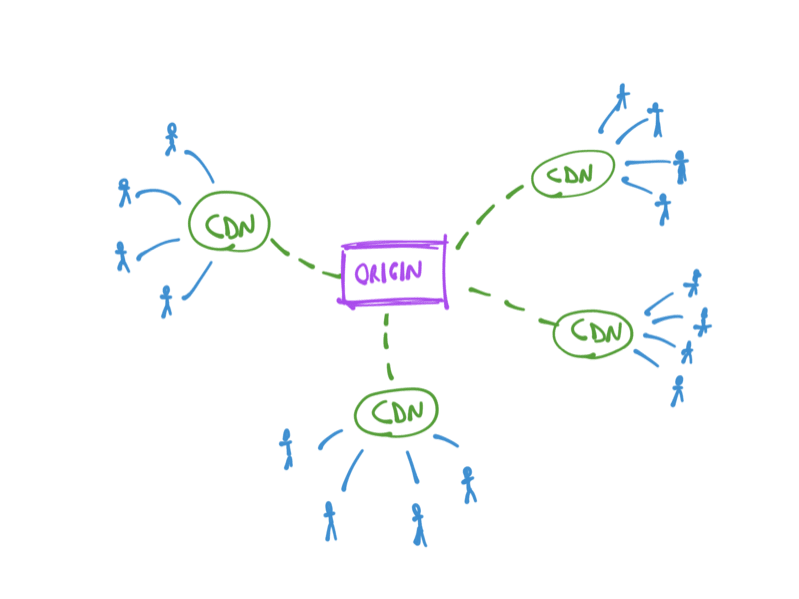Hello folk! Today we’re going to talk about CDN witch is a part of our global topic “Web Api Performance” and i hope that you guys are ready!
Let’s go 🚀 …
What is a CND ?
In web API performance, a CDN stands for “Content Delivery Network.” A CDN is a network of distributed servers strategically placed in multiple data centers around the world.
What is it used for ?
The primary purpose of a CDN is to deliver web content, including APIs, to users more efficiently by reducing latency and improving availability and scalability. CDN caches contents next to the final users so that it can send resources quickly to them.
Resources like
Static Content: HTML pages, Javascript files, css styles, images, videos.
Dynamic Content: While CDNs are primarily known for caching static content, some CDNs offer features for caching dynamic content as well. This includes dynamically generated web pages, API responses, and database-driven content.
Software Updates: CDNs are used to distribute software updates and patches. Companies often use CDNs to deliver software updates to their users, ensuring faster and more reliable downloads.
Streaming Media: Many CDNs support the delivery of streaming media content, such as video and audio streams. Content can be distributed globally to reduce latency for viewers.
Large Files: CDNs are also useful for distributing large files, such as software installation files, documents, and datasets. They can efficiently handle the transfer of large files to users, again reducing the load on your origin server.
CDNs vs Web Hosting
Sometimes when defining CDNs, they can be confused with web hosting. So we added this section to explain the difference and make it clear to you.
Web hosting is primarily used to store and serve website files, databases, and web applications from a centralized server, while CDN is to enhance the delivery speed, availability, and scalability of web content.
When it’s about content delivery, DNs distribute cached content globally, making use of edge servers to serve content from locations closer to end-users, while Web hosting serves content from a central server, which may not be optimized for global content delivery. Without a CDN, users farther from the hosting server may experience slower load times.
Finally a website can use a Content Delivery Network (CDN) to improve its performance, reliability, and content delivery. By using a CDN, a website can provide a better user experience by reducing latency, improving load times, and enhancing content delivery to users around the world.
But CDNs are independent services that work in conjunction with websites, but they don’t require a specific website to function.
*How do they work ?
*
Different CDNs use different process and technologies for driving user requests to the closest POPs..
— Let’s take a break! What is a PoP?
PoP stands for Point of Presence and is one of the multiple servers deployed by a CDN at multiple locations all over the world.
Now we continue with the explanation of how a CDN works 👇🏾
There is a lot of technologies that CDNs use but two common technologies are : DNS-Based Routing and AnyCast
DNS-Based Routing:
In DNS-Based Routing, each Point of Presence (PoP) has it’s own IP address so when the user request for a specific content to a CDN, this one (The CDN) returns the IP address of the PoP closest to the user.
AnyCast:
Things go differently with the anycast process, because in this case all PoPs have the same IP address and when a user request arrives on the anycast network, the network redirects the request to the nearest PoP to the requester .
Conclusion:
Using a Content Delivery Network (CDN) offers several key advantages:
Improved Performance: CDNs reduce latency by caching and delivering content from edge servers geographically closer to users, resulting in faster load times.
Scalability: CDNs efficiently handle traffic spikes, ensuring your website or application remains responsive even during high-demand periods.
Global Reach: CDNs have a worldwide presence, making your content accessible and fast for users across the globe.
Caching: They cache static and dynamic content, reducing the load on your origin server and minimizing server costs.
Security: CDNs often provide security features like DDoS protection and web application firewalls, enhancing your website’s protection.
Cost Efficiency: CDNs can lower bandwidth and server costs while improving performance and reliability.
In conclusion, CDNs enhance content delivery, performance and scalability for websites and applications, ensuring a faster, more reliable, and cost-effective user experience.
Follow me there :
linkedin.com/in/laetitia-christelle-ouelle-89373121b/
twitter.com/OuelleLaetitia
dev.to/ouelle
Happy coding ! 😏



Top comments (0)